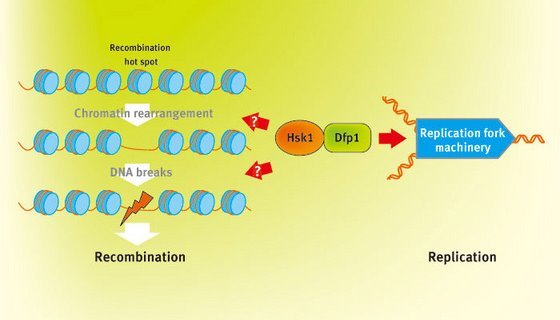Aug. 11, 2006 Research Highlight Biology
Connecting loose ends
New research has identified a protein which may have a key role in organizing several functions essential to sexual reproduction
 Figure 1: Hsk1—working with protein partners such as Dfp1—appears to participate in the regulation of both pre-meiotic DNA replication and subsequent physical chromosomal changes that allow recombination to take place.
Figure 1: Hsk1—working with protein partners such as Dfp1—appears to participate in the regulation of both pre-meiotic DNA replication and subsequent physical chromosomal changes that allow recombination to take place.
Cells from diploid eukaryotic organisms—such as humans and yeast—normally contain two copies of each chromosome, with the exception of reproductive cells, or gametes, which contain only a single copy. These copies, or homologs, are not identical, but contain numerous sequence variations that can affect the expression of heritable traits like hair colour or, less benignly, predisposition to certain diseases. This variability is enhanced by recombination—the routine swapping of information between homologs—during gamete production, which takes place via a process known as meiosis.
“Recombination between homologous chromosomes during meiosis is vital for the generation of genetic diversity and proper gamete formation in sexual reproduction in eukaryotes,” explains Kouji Hirota, of the RIKEN Discovery Research Institute in Wako. Previous research has suggested that chromosomal DNA replication—an essential preparatory step for meiosis—is somehow linked with the subsequent process of recombination. But, Hirota adds, “there is little molecular evidence for such linkage.”
Hirota and colleagues from RIKEN recently collaborated with Hisao Masai’s group at the Tokyo Metropolitan Institute of Medical Science to investigate a protein that might tie these functions together. The protein Hsk1 from fission yeast has previously been associated with the regulation of DNA replication and DNA repair. Masai and Hirota’s teams decided to further investigate its function with a mutant yeast strain that only produces functional Hsk1 at certain temperatures, allowing them to effectively turn the protein’s activity on or off. Their findings are published in the Proceedings of the National Academy of Sciences 1.
Initial experiments showed that inactivation of Hsk1 delays, but doesn’t halt, DNA replication, although subsequent cell division is stalled. More surprising, however, was the finding that Hsk1 inactivation appears to induce marked defects in chromosomal recombination.
Recombination is generally preceded by rearrangements of the proteins that organize and condense chromosomal DNA into chromatin, followed by the formation of breaks in the DNA itself. Disrupting the activity of Hsk1 appears to prevent either of these processes from taking place (Fig. 1).
“These findings provide us with knowledge of more direct molecular links between DNA replication and recombination initiation during meiosis,” says Hirota. This work links Hsk1 with a number of important functions relating to meiosis, but it still remains unclear how these processes are connected. Hirota indicates that he and his colleagues are now exploring the function of Hsk1—and any potential protein partners—more closely.
References
- 1. Ogino, K., Hirota, K., Matsumoto, S., Takeda, K., Ohta, K., Arai, K. & Masai, H. Hsk1 kinase is required for induction of meiotic dsDNA breaks without involving checkpoint kinases in fission yeast. Proceedings of the National Academy of Sciences USA 103, 8131–8136 (2006). doi: 10.1073/pnas.0602498103
